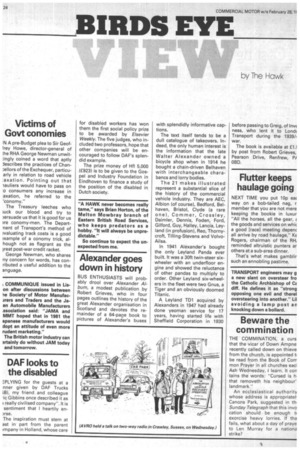Alexander goes down in history
Page 26

If you've noticed an error in this article please click here to report it so we can fix it.
BUS ENTHUSIASTS will probably drool over Alexander Album, a modest publication by Robert Grieves, who in four pages outlines the history of the great Alexander organisation in Scotland and devotes the remainder of a 64-page book to pictures of Alexander's buses
with splendidly informative captions.
The text itself tends to be a dull catalogue of takeovers. Indeed, the only human interest is the information that the late Walter Alexander owned a bicycle shop when in 1914 he bought a chain-driven Belhaven with interchangeable charabancs and lorry bodies.
The 21 makes illustrated represent a substantial slice of the history of the commercial vehicle industry. They are AEC, Albion (of course), Bedford, Belhaven, Bristol, Clyde (a rare onel, Commer, Crossley, Daimler, Dennis, Foden, Ford, Gilford, Guy, Halley, Lancia, Leyland (in profusion), Reo, Thornycroft, Tilling-Stevens and VolvoAilsa.
In 1941 Alexander's bought the only Leyland Panda ever built. It was a 30ft twin-steer sixwheeler with an underfloor engine and showed the reluctance of other pandas to multiply to order. Other Leyland six-wheelers in the fleet were two Gnus, a Tiger and an obviously doomed Titanic.
A Leyland TD1 acquired by Alexanders in 1947 had already done yeoman service for 17 years, having started life with Sheffield Corporation in 1930
before passing to Greig, of Inv( ness, who lent it to Land( Transport during the 1939/, war.
The book is available at EU by post from Robert Grieves, Pearson Drive, Renfrew, Pi OBD.




























































































